Related Research Articles

Biscayne National Park is a national park of the United States located south of Miami, Florida, in Miami-Dade County. The park preserves Biscayne Bay and its offshore barrier reefs. Ninety-five percent of the park is water, and the shore of the bay is the location of an extensive mangrove forest. The park covers 172,971 acres and includes Elliott Key, the park's largest island and northernmost of the true Florida Keys, formed from fossilized coral reef. The islands farther north in the park are transitional islands of coral and sand. The offshore portion of the park includes the northernmost region of the Florida Reef, one of the largest coral reefs in the world.

Biscayne Bay is a lagoon with characteristics of an estuary located on the Atlantic coast of South Florida. The northern end of the lagoon is surrounded by the densely developed heart of the Miami metropolitan area while the southern end is largely undeveloped with a large portion of the lagoon included in Biscayne National Park.

South Beach, also nicknamed colloquially as SoBe, is a neighborhood in Miami Beach, Florida. It is located east of Miami between Biscayne Bay and the Atlantic Ocean. The area encompasses Miami Beach south of Dade Boulevard.
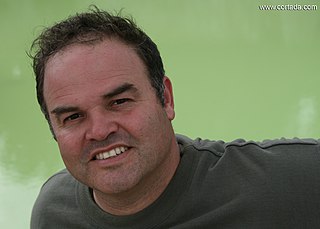
Xavier Ignacio Cortada is an American eco artist, public artist, and former lawyer. As a National Science Foundation Antarctic Artists and Writers Program fellow and a New York Foundation for the Arts-sponsored Artist, Cortada created works at the North Pole and South Pole to generate awareness about global climate change.

Miami Modernist architecture, or MiMo, is a regional style of architecture that developed in South Florida during the post-war period. The style was internationally recognized as a regionalist response to the International Style. It can be seen in most of the larger Miami and Miami Beach resorts built after the Great Depression. Because MiMo styling was not just a response to international architectural movements but also to client demands, themes of glamour, fun, and material excess were added to otherwise stark, minimalist, and efficient styles of the era. The style can be most observed today in Middle and Upper Miami Beach along Collins Avenue, as well as along the Biscayne Boulevard corridor starting from around Midtown, through the Design District and into the Upper Eastside.

The Miami-Dade Zoological Park and Gardens, also known as Zoo Miami, is a zoological park and garden in Miami and is the largest zoo in Florida. Originally established in 1948 at Crandon Park in Key Biscayne, Zoo Miami relocated in 1980 as Miami MetroZoo to the former location of the Naval Air Station Richmond, southwest of Miami in southern unincorporated Miami-Dade County, surrounded by the census-designated places of Three Lakes (north), South Miami Heights (south), Palmetto Estates (east) and Richmond West (west).
The barefoot mailman is an iconic Florida symbol. It refers to the carriers on the first U.S. Mail route (1885–1892) between Palm Beach and the settlements around Lake Worth on the north, and Miami, Coconut Grove, and Lemon City to the south. The mailmen had to walk and travel by boat because there was no road connecting the 68-mile route from Palm Beach to Miami. Approximately 28 miles of the one way trip was by rowing different boats, and the rest by walking along the firmer sand along the beach. The route was a Star Route, with the carriers contracting with the Post Office. The route was originally called the "barefoot route" and the carriers were called "beach walkists" or "beach walkers". It was not until around 1940 that the term "barefoot mailman" came into use.
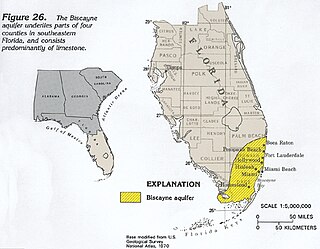
The Biscayne Aquifer, named after Biscayne Bay, is a surficial aquifer. It is a shallow layer of highly permeable limestone under a portion of South Florida. The area it underlies includes Broward County, Miami-Dade County, Monroe County, and Palm Beach County, a total of about 4,000 square miles (10,000 km2).

Belle Isle is a neighborhood in the city of Miami Beach on an island in Biscayne Bay, Florida, United States. It is the easternmost of the Venetian Islands, a chain of artificial islands in Biscayne Bay in the cities of Miami and Miami Beach. It is home to apartment buildings, a portion of the Venetian Causeway, a city of Miami Beach park, and a hotel. It is between Rivo Alto Island and the main barrier island of Miami Beach.
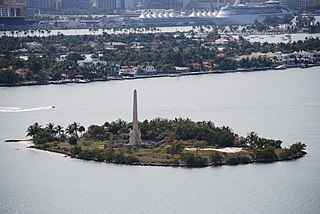
Flagler Memorial Island is an uninhabited artificial island of South Beach in the city of Miami Beach in Biscayne Bay, Florida. A 110-foot (34 m) high obelisk with allegorical sculptures at its base stands as a monument to Miami pioneer Henry M. Flagler, and was built in the center of the freshly constructed island in memory of Flagler, who died in 1913.

The Flamingo Hotel overlooked Biscayne Bay on the west side of the newly formed city of Miami Beach, Florida, until the 1950s, when it was torn down to make room for the new Morton Towers development, which is now known as the Flamingo South Beach.

OSGEMEOS are identical twin street artists Otavio Pandolfo and Gustavo Pandolfo. They started painting graffiti in 1987 and their work appears on streets and in galleries across the world.

Invader is a pseudonymous French street artist identified as Franck Slama. He is known for his ceramic tile mosaics modeled on the pixelated art of 1970s–1980s 8-bit video games, many of which depict the titular aliens from the arcade games Space Invaders, Pac-Man and Super Mario Bros.. As of December 2020, his creations can be seen in highly-visible locations in 79 cities in 20 countries. To accompany his citywide installations, or "Invasions", Invader publishes books and maps as guides to the locations of his mosaics.
Susan Silas is a visual artist working primarily in video, sculpture and photography. Her work, through self-portraiture, examines the meaning of embodiment, the index in representation, and the evolution of our understanding of the self. She is interested in the aging body, gender roles, the fragility of sentient being and the potential outcome of the creation of idealized selves through bio-technology and artificial intelligence.
AndreaMosaic is freeware graphic art software developed and published by Andrea Denzler and that specializes in the creation of photographic mosaic images.
Isle of Normandy or Normandy Island or Normandy Isles or Normandy Isle is a neighborhood of North Beach in the city of Miami Beach, Florida. It is located along the eastern shore of Biscayne Bay.

Thierry Guetta, best known by his moniker Mr. Brainwash, is a French-born Los Angeles–based street artist. According to the 2010 Banksy-directed film Exit Through the Gift Shop, Guetta was a proprietor of a used clothing store, and amateur videographer who was first introduced to street art by his cousin, the street artist Invader, and who filmed street artists through the 2000s and became an artist in his own right in a matter of weeks after an off-hand suggestion from Banksy.

David Datuna was a Georgian-born American artist who lived in New York City. His Viewpoint of Millions series explores the sources and meaning of cultural identity from different points of view.
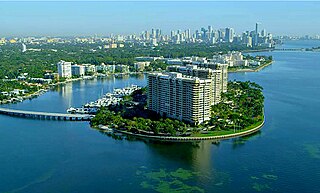
Grove Isle is a 20-acre (81,000 m2) island lying off the north-east coast of Miami's Coconut Grove neighborhood. Three waterfront hi-rise residences have been built on the island which were master-planned to include a resort hotel, restaurants, marina, club amenities and services.
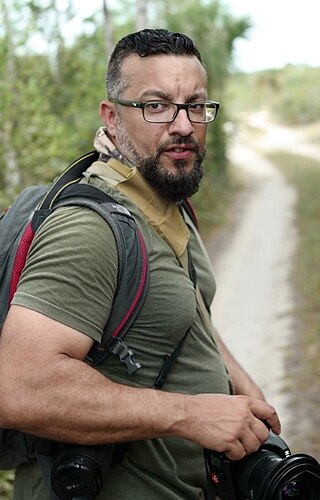
JohnBob Carlos is an American photographer and environmental activist living and working in Florida. Active since the early 1990s. His work consists mostly of color photography of the Florida Everglades landscape, its people, and culture.
References
- ↑ "Gator In The Bay - Illustration" . Retrieved 2014-09-05.
- ↑ McCorquodale, Amanda (August 1, 2012). "Gator In The Bay: 230-Foot Alligator In Biscayne Bay For Art Basel Miami Beach (VIDEO, PHOTOS)". The Huffington Post . Retrieved January 4, 2014.
- ↑ Rodriguez, Ihosvani (November 23, 2013). "Giant gator sculpture to float down New River this year, bigger than ever". Sun-Sentinel . Archived from the original on December 2, 2013. Retrieved January 4, 2014.
- ↑ Litz, Steve (December 6, 2013). "Art Basel: "Gator in the Bay" Gets a Tail". NBC 6 South Florida . Retrieved January 4, 2014.
- 1 2 "Huffington Post - Gator in the Bay" . Retrieved 2014-09-05.
- ↑ "Tropicult - Gator in the Bay Returns!" . Retrieved 2014-09-05.
- ↑ "Local 10 - 'Gator in the Bay' ready to set sail" . Retrieved 2014-09-05.
- ↑ Suarez de Jesus, Carlos (October 1, 2013). "Gator in the Bay Celebrates Its Second Art Basel in Miami Beach". The Miami New Times. Retrieved August 4, 2021.
- 1 2 "Gator in the Bay Heads to Miami for Art Basel". nbcmiami.com. Retrieved 3 December 2013.
- ↑ Sentenac, Hannah. "Free Events This Week: Tweet Up, Winterfest, and Gator In the Bay". miaminewtimes.com. Retrieved 3 December 2013.
- ↑ "Gator replica to take bite out of Art Basel". wsvn.com. Retrieved 3 December 2013.